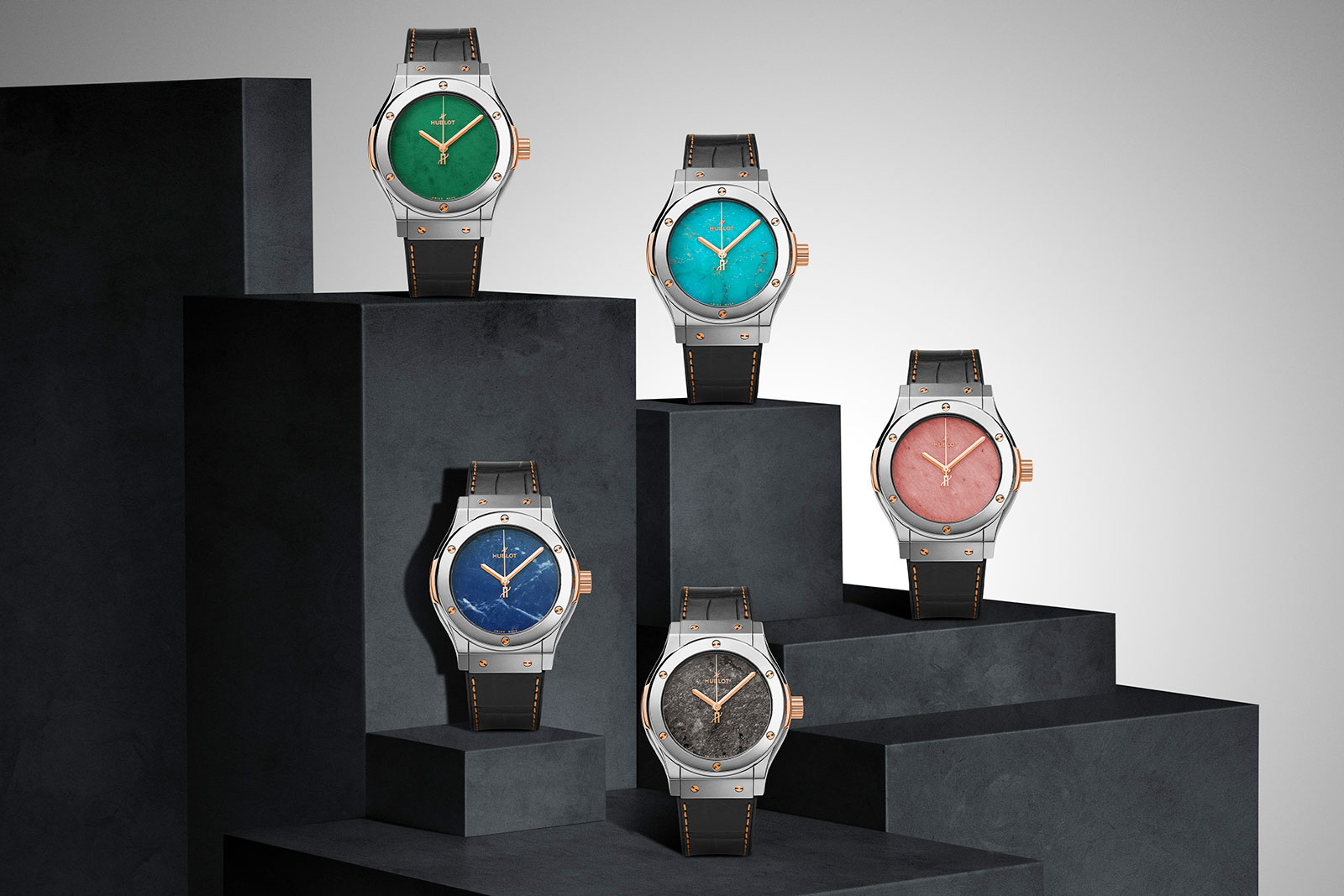Hublot Returns to Mineral Stone Dials with Classic Fusion Elements II
Fusion of stone and alloy.
Two years ago Hublot introduced mineral stone dials for the first time and now the brand has returned to Earth’s rare natural stones – and one from elsewhere in the galaxy – with the Classic Fusion Elements II.
As with the first edition, the Elements II is a limited edition for Singapore retailer The Hour Glass made up of five different models, each sporting a dial of mineral stone: pink jasper, sodalite, nephrite jade, turquoise, and lunar meteorite.
The Elements II is based on Hublot’s signature time-only watch, a minimalist design with the trademark porthole-shaped bezel and case. With just three hands and no date, plus the Hublot logo in gold-powder print, the dial is a blank slate that allows the grain of each mineral stone to stand out.
Turquoise
Initial thoughts
Hublot does two things well, the minimalist, classic Hublot, and artist collaborations, particularly the recent Daniel Arsham and earlier Takashi Murakami. The Elements II is essentially a classic Hublot with a mineral stone dial free of any markings save for the brand logo in gilt print. The clean aesthetic of the dial is maximised to show off the natural graining of various mineral stones.
The case is unusual for being entirely in polished titanium, and also two-tone thanks to 18k gold accents, but it’s a perfect complement to the colours of the mineral stone dials.
Lunar meteorite
This might seem surprising given the clean styling of the watch, but the stone dials would have arguably been even more striking in the full-size, 45 mm Classic Fusion instead of the 42 mm as it is now.
A larger case would also have resulted in a wider space for the mineral stone dials. At the same time, the 45 mm model has slightly more elegant proportions – it feels thinner because the case thickness is similar but the case is wider.
Pink jasper
From Earth and the cosmos
Each of the stone dials – pink jasper, sodalite, nephrite jade, turquoise, and lunar meteorite – vary in appearance (and price). At a distance, the nephrite appears to be an almost-uniform forest green, but reveals a fine graining up close.
The nephrite jade model
Up close the nephrite jade dial reveals both texture and shading
The turquoise and sodalite dials, on the other hand, reveal prominent veining that gives them a distinctive look that is synonymous with mineral stone.
Sodalite
The priciest of the Elements II is the lunar meteorite. This is unusual as it is made from a different type of meteorite than most watch dials.
Majority of meteorite watch dials are made of iron meteorite, essentially an alloy of iron and nickel, that originate from asteroids. The large Gibeon meteorite that landed in what is now Namibia is most often used for watch dials, simply because supply is plentiful.
Lunar meteorites, in contrast, are meteorites that come from the moon. These are typically rock, explaining the mineral-like appearance of the Elements II with a meteorite dial, instead of the familiar streaky graining of an ironmeteorite dial.
The lunar meteorite dial
Like the preceding editions, the Elements II uses the mid-size Classic Fusion case that’s a handy 42 mm wide and 10.4 mm. It’s a compact size that’s easy to wear, but it looks slightly smaller than it is, perhaps because Hublot watches are generally large.
Unusually, the case is almost entirely polished titanium, an unusual finish for the model, which typically employs both matte brushing and mirror polishing. The polished titanium is matched with 18k gold for the screws, crown, and under-bezel for a two-tone effect.
Sodalite
The only part of the case that is polished is the back. Notably, the case back is secured with gold screws as well, reflecting the attention to detail in the design. The open back reveals the HUB1112, which is a Sellita SW300-1 dressed up with an open-worked rotor. A watch like this deserves a more sophisticated calibre, and that will come with time as it is known that Hublot has an in-house automatic in the works.
Key facts and price
Hublot Classic Fusion 42 mm Elements II
Ref. 542.NX.6280.LR.THG (Pink jasper)
Ref. 542.NX.5180.LR.THG (Sodalite)
Ref. 542.NX.5280.LR.THG (Nephrite jade)
Ref. 542.NX.6380.LR.THG (Turquoise)
Ref. 542.NX.5580.LR.THG (Lunar meteorite)
Diameter: 42 mm
Height: 10.4 mm
Material: Titanium and 18k gold
Crystal: Sapphire
Water resistance: 100 m
Movement: HUB1112 (Sellita SW300-1)
Functions: Hours, minutes, and seconds
Winding: Automatic
Frequency: 28,800 beats per hour (4 Hz)
Power reserve: 42 hours
Strap: Alligator covered rubber with folding clasp
Limited edition: 10 pieces in each dial variation
Availability: At The Hour Glass stores in Singapore, Malaysia, Thailand, and Vietnam
Price: (Including Singapore taxes)
Jasper, and Sodalite – 31,700 Singapore dollars, or about US$24,500
Nephrite Jade – 32,400 Singapore dollars, or about US$25,100
Turquoise – 34,800 Singapore dollars, or about US$26,900
Lunar Meteorite – 43,200 Singapore dollars, or about US$33,500
For more, visit thehourglass.com.
This was brought to you in partnership with The Hour Glass.
Back to top.